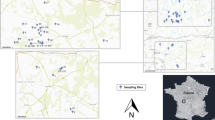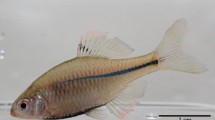Abstract
Since 2005, the ctenophore Mnemiopsis leidyi has been reported as present in northern Europe. Although the impacts of this voracious predator on North Sea fisheries remain uncertain, it is in direct competition with fish larvae for food availability and is considered a threat to the structure and function of the marine ecosystem. M. leidyi has never been officially recorded in UK coastal waters but it has been listed among the most likely species to arrive within the next 10 years by a panel of experts. The threat is confirmed by recurrent visual observations of M. leidyi in the North Sea, as well as the identification of suitable areas to establish a population in the same area. In this study, we developed and validated an environmental DNA (eDNA) protocol to detect the presence of M. leidyi in the water of an economically-important shellfishery. This technique is based on the detection of DNA from cells secreted by an organism into its environment and is particularly suitable to detect a low number of individuals. A set of specific primers were used to target a region in the mitochondrial COI locus. Conventional PCR and SYBR® Green quantitative PCR assays were optimised and compared for sensitivity during laboratory experiments describing the kinetic of DNA released by M. leidyi. Natural water samples were collected in The Wash on the North Norfolk coast between 2010 and 2014 and tested. Samples taken only in 2014 were positive for the presence of M. leidyi, although no visual observation of individuals was reported to confirm the establishment of a population. This study showed how powerful eDNA analyses could be used to investigate the pathway and early invasion stages of alien invasive species such as M. leidyi by complementing the traditional monitoring techniques.





Similar content being viewed by others
References
Antajan E, Bastian T, Raud T, Brylinski JM, Hoffman S, Breton G, Cornille V, Delegrange A, Vincent D (2014) The invasive ctenophore Mnemiopsis leidyi A. Agassiz, 1865 along the English Channel and the North Sea French coasts: another introduction pathway in northern European waters? Aquat Invasions 9:167–173
Blackman RC, Constable D, Hahn C, Sheard AM, Durkota J, Hänfling B, Lawson Handley L (2017) Detection of a new non-native freshwater species by DNA metabarcoding of environmental samples—first record of Gammarus fossarum in the UK. Aquat Invasions 12:177–189
Bolte B, Goldsbury J, Huerlimann R, Jerry D, Kingsford M (2021) Validation of eDNA as a viable method of detection for dangerous cubozoan jellyfish. Environ DNA 3:769–779
Collingridge K, Van Der Molen J, Pitois S (2014) Modelling risk areas in the North Sea for blooms of the invasive comb jelly Mnemiopsis leidyi A. Agassiz, 1865. Aquat Invasions 9:21–36
Collins R, Wangensteen OW, O’Gorman EJ et al (2018) Persistence of environmental DNA in marine systems. Commun Biol 1:185
Costello JH, Sullivan BK, Gifford DJ, Van Keuren D, Sullivan LJ (2006) Seasonal refugia, shoreward thermal amplification, and metapopulation dynamics of the ctenophore Mnemiopsis leidyi in Narragansett Bay, Rhode Island. Limnol Oceanogr 51:1819–1183
Costello JH, Bayha KM, Mianzan HW, Shiganova TA, Purcell JE (2012) Transitions of Mnemiopsis leidyi (Ctenophora: Lobata) from a native to an exotic species: a review. Hydrobiologia 690:21–46
Crane LC, Goldstein JS, Thomas DW, Rexroth KS, Watts Aw (2021) Effects of life stage on eDNA detection of the invasive European green crab (Carcinus maenas) in estuarine systems. Ecol Ind 124:107412
Crooks JA (2005) Lag times and exotic species: the ecology and management of biological invasionsin slow-motion. Ecoscience 12:316–329
Darling JA, Galil BS, Carvalho GR, Rius M, Viard F, Piraino S (2017) Recommendations for developing and applying genetic tools to assess and manage biological invasions in marine ecosystems. Mar Policy 85:54–64
Drake JM, Lodge DM (2004) Global hot spots of biological invasions: evaluating options for ballast-water management. Proc R Soc Lond B 271:575–580
Ficetola GF, Miaud C, Pompanon F, Taberlet P (2008) Species detection using environmental DNA from water samples. Biol Lett 4:423–425
Ghabooli S, Shiganova TA, Briski E, Piraino S, Fuentes V, Thibault-Botha D, Angel DL, Cristescu ME, MacIsaac HJ (2013) Invasion pathway of the Ctenophore Mnemiopsis leidyi in the Mediterranean Sea. PLoS ONE 8:e81067
Gesamp (1997) Opportunistic settlers and the problem of the ctenophore Mnemiopsis leidyi invasion in the Black Sea GESAMP reports and studies. Int Marit Organ 58, 84
Goldberg CS, Turner CR, Deiner K, Klymus KE, Thomsen PF, Murphy MA, Spear SF, McKee A, Oyler-McCance SJ, Cornman RS, Laramie MB, Mahon AR, Lance RF, Pilliod DS, Strickler KM, Waits LP, Fremier AK, Takahara T, Herder JE, Taberlet P (2016) Critical considerations for the application of environmental DNA methods to detect aquatic species. Methods Ecol Evol 7:1299–1307
Holman L, de Bruyn M, Creer S, Carvalho G, Robidart J, Ruis M (2019) Detection of introduced and resident marine species using environmental DNA metabarcoding of sediment and water. Sci Rep 9:11559
Hamer HH, Malzahn AM, Boersma M (2011) The invasive ctenophore Mnemiopsis leidyi: a threat to fish recruitment in the North Sea? J Plankton Res 33:137–144
Hering D, Borja A, JOnes JI, Pont D, Boets P, Bouchez A, Bruce K, Drakare S, Hänfling, Kahlert, Leese F, Meissner K, Mergen P, Reyjol Y, Seguro P, Vogler A, Kelly M (2018) Implementation options fro DNA-based idenfication into ecological status assessment under the Euroepan Water Framework Directive. Water Res 138:192–205
Ivanov VP, Kamakon AM, Ushivtzev VB, Shiganova T, Zhukova O, Aladin N, Wilson SI, Harbison GR, Dumont HJ (2000) Invasion of the Caspian Sea by the Comb jellyfish Mnemiopsis leidyi (Ctenophora). Biol Invasions 2:255–258
Jaspers C, Titelman J, Hansson LJ, Haraldsson M, Ditlefsend CR (2011) The invasive ctenophore Mnemiopsis leidyi poses no direct threat to Baltic cod eggs and larvae. Limnol Oceanogr 56:431–439
Jaspers C, Møller LF, Kiørboe T (2011) Salinity gradient of the Baltic Sea limits the reproduction and population expansion of the newly invaded comb jelly Mnemiopsis leidyi. PLoS ONE 6:e24065
Jaspers C, Huwer B, Antajan E, Hosia A et al (2018) Ocean current connectivity propelling the secondary spread of a marine invasive comb jelly across western Eurasia. Glob Ecol Biogeogr 27:814–827
Jerde CL, Mahon AR, Chadderton WL, Lodge DM (2011) "Sight-unseen” detection of rare aquatic species using environmental DNA. Conserv Lett 4:150–157
Jerde CL (2019) Can we manage fisheries with the inherent uncertainty from eDNA. J Fish Biol 98:341–353
Jessop RW, Maxwell E (2011) https://www.eastern-ifca.gov.uk/wp-content/uploads/2016/04/Eastern-IFCA-Research-Report-2011-condensed.pdf
Kideys AE (1994) Recent dramatic changes in the Black Sea ecosystem: the reason for the sharp decline in Turkish anchovy fisheries. J Mar Syst 5:171–181
Kim P, Kim D, Yoon TJ, Shin S (2018) Early detection of marine invasive species, Bulgula neritina (Bryozoa: Cheilostomatida), using species-specific primers and environmental DNA analysis in Korea. Mar Environ Res 139:1–10
Minamoto T, Fikuda M, Katsuhara KR, Fujiwara A, Hidaka S, Yamamoto S, Takahashi K, Masuda R (2017) Environmental DNA reflects spatial and temporal jellyfish distribution. PLoS ONE 12:e0173073
Miralles L, Parrondo M, Hernández de Rojas A et al (2019) Development and validation of eDNA markers for the detection of Crepidula fornicata in environmental samples. Mar Pollut Bull 146:827–830
Nielsen KM, Johnsen PJ, Bensasson D, Daffonchio D (2007) Release and persistence of extracellular DNA inthe environment. Environ Biosaf Res 6:37–53
Rees HC, Bishop K, Middleditch DJ, Patmore JR, Maddison BC, Gough KC (2014) The application of eDNAfor monitoring of the great crested newt in the UK. Ecol Evol 4:4023–4032
Roy HE, Peyton J, Aldridge DC et al (2014) Horizon scanning for invasive alien species with potential to threaten biodiversity in Great Britain. Glob Change Biol 20:3859–3871
Sepulveda AJ, Nelson NM, Jerde CL, Luikart G (2020) Can we manage fisheries with the inherent uncertainty from eDNA. Trends Ecol Evol 35:668–678
Shiganova TA, Mirzoyan ZA, Studenikina EA (2001) Population development of the invader ctenophore Mnemiopsis leidyi, in the black sea and in other seas of Mediterranean basin. Mar Biol 139:431–445
Simpson TJS, Dias PJ, Snow M, Muñoz M, Berry T (2016) Real-time PCR detection of Didemnum perlucidum (Monniot, 1983) and Didemnum vexillum (Kott, 2002) in an applied routine marine biosecurity context. Mol Ecol Resour 17:443–453
Stebbing P, Murray J, Whomerseley P, Tidbury H (2014) Monitoring and surveillance for non-indigenous species in UK marine water. randd.defra.gov.uk/ Document ME5215
Thomsen PF, Willerslev (2015) Environmental DNA—an emerging tool in conservation for monitoring past and present biodiversity. Biol Cons 183:4–18
Trebitz AS, Hoffman JC, Darling JA (2017) Early detection monitoring for aquatic non-indigenous species: optimizing surveillance, incorporating advanced technologies, and identifying research needs. J Environ 202:299–310
Vaughan RW (1978) A study of common seals in the Wash. Mammal Rev 8:25–34
Van Der Molen J, Van Beek J, Augustine S, Vansteenbrugge L, Van Walraven L, Langenberg V, Hostens K, Pitois S, Robbens J (2015) Modelling survival and connectivity of Mnemiopsis leidyi in the south-western North Sea and Scheldt estuaries. Ocean Sci 11:405–424
Vila M, Espinar JL, Hejda M, Hulme PE, Jarosik V, Maron JL, Pergl J, Schaffner U, Sun Y, Pysek P (2011) Ecological impacts of invasive alien plants: a meta-analysis of their effects on species, communities and ecosystems. Ecol Lett 14:702–708
Wood SA, Biessy L, Latchford JL, Zaiko A, von Ammon U, Audrezet F, Cristescu ME, Pochon X (2020) Release and degradation of environmental DNA and RNA in a marine system. Sci Total Environ 704:135314
Xia Z, Zhan A, Johansson ML, DeRoy E, Haffner GD, MacIsaac HJ (2021) Screening marker sensitivity: optimizing eDNA-based rare species detection. Divers Distrib 27:1981–1988. https://doi.org/10.1111/ddi.13262
Acknowledgements
This research was financed by the European Regional Development Fund (ERDF) within the framework of the InterReg IVa 2 Seas project ‘Safeguarding the Environment from Invasive Non-native Species’ (SEFINS) and an additional contribution from UK Government Department for Environment, Food and Rural Affairs DEFRA under Grant ME5319 (Hierarchical Assessment of Zooplankton According to Risks and for MSFD Descriptors: HAZARD). The authors would also like to thank Ron Jessop from Eastern IFCA for facilitating the sampling in The Wash, Aquarium Nausicaä for providing the individuals of M. leidyi and facilities needed for this work, Kirsten Leluel (Université de Bretagne Sud) for her technical assistance. We would also like to thank the anonymous reviewers and associate editor for their comments and Dr. D. Sheahan for his proof reading and approval for submitting this work.
Author information
Authors and Affiliations
Corresponding author
Additional information
Publisher’s Note
Springer Nature remains neutral with regard to jurisdictional claims in published maps and institutional affiliations.
Rights and permissions
About this article
Cite this article
Créach, V., Derveaux, S., Owen, K.R. et al. Use of environmental DNA in early detection of Mnemiopsis leidyi in UK coastal waters. Biol Invasions 24, 415–424 (2022). https://doi.org/10.1007/s10530-021-02650-0
Received:
Accepted:
Published:
Issue Date:
DOI: https://doi.org/10.1007/s10530-021-02650-0




